Coping with chronic pain can be exhausting, and prescription painkillers may not be available during a survival situation.
Thankfully, there are alternatives out there that can help you manage pain. These options may be much easier to get your hands on should the system collapse or some other event prevent you from seeing your regular practitioner.
Opiate painkillers are the most prescribed medications in the United States today. According to the recent U.S. Surgeon General’s Report, over 289 million prescriptions are written each year for analgesic pain relievers.
Many of these medications are highly addictive and require regular doctor visits to obtain. Thus opiate alternatives are always a good option in everyday life and during an emergency.
Natural Painkillers to Use Instead of Opiates
1. Kratom
 Kratom is a natural option for pain relief in the event of an emergency.
Kratom is a natural option for pain relief in the event of an emergency.
Derived from a type of evergreen tree, Kratom acts upon the nervous system to produce pain-relieving effects in the same way that opiates work.
The plant contains alkaloid compounds called mitragynine and 7-hydroxy mitragynine, which help treat pain and act as a mild stimulant when taken in low doses. Kratom comes in powder form, making it easy to store and use.
Related: How to Identify and Use Kratom – the Painkilling Plant that Substitutes Opioids
Kratom may also be helpful to have on hand in an emergency to help you cope with withdrawal symptoms if you cannot obtain your opiate medications from a doctor or pharmacy.
Since Kratom works on the same receptors as opiate medications, such as morphine or oxycodone, it can treat pain and can be used as a substitute for opiate medications in an emergency, alleviating your pain and warding off withdrawals.
Uses and Risks
Kratom is praised for many uses, including relaxation, improved mood, relief of anxiety, increased energy, and effectively relieving pain.
However, it also comes with some risks. Kratom use has been reported to increase the risk of sunburn, cause nausea, itching, dry mouth, constipation, increased urination, insomnia, and loss of appetite.
Kratom is currently listed as a drug of concern by the Drug Enforcement Administration (DEA), and the Food and Drug Administration (FDA) has not yet approved it for medical use.
However, it is available for purchase online and in many places around the world. You can also grow your own Kratom plants to use for pain relief if you desire.
How It Works
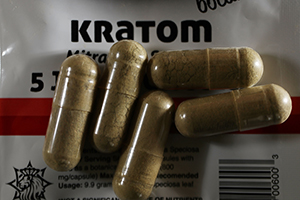 Kratom is an agonist that binds to mu-opioid receptors in the brain.
Kratom is an agonist that binds to mu-opioid receptors in the brain.
These receptors are activated when you take opioids such as prescription painkillers or heroin. Researchers believe the painkilling effects of Kratom come from mitragynine and 7-hydroxy mitragynine.
These compounds attach to pain receptors in the brain and reduce pain perception.
Like many prescription alternatives, Kratom has gained popularity as an opiate alternative. Some people claim that Kratom helps ease withdrawal symptoms when quitting opiates, making it an excellent choice to have on hand during an emergency.
How To Use It In A Survival Situation
The great thing about Kratom is that it works on the same receptors that opiates work on in the brain. This means that in a survival situation when you are unable to obtain your medication from a doctor or pharmacist safely, Kratom can be used as a replacement without the fear of withdrawal or other issues.
Kratom is excellent for treating pain and creates feelings similar to opiates when used correctly. Also, creating a solution and using Kratom at home is easy.
Create Kratom Tea
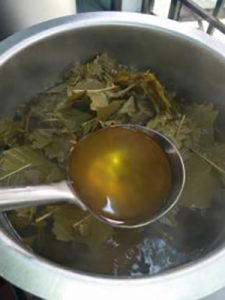
Kratom is usually purchased in powder form, making it ideal for creating tea. You can simply add the powder to boiling water and drink.
However, if you want to improve the flavor (Kratom is generally found to be bitter and unpleasant in taste), create kratom tea precisely as you would a regular cup of tea, using a teabag to strain the liquid through the powder and dilute the taste.
You can purchase Kratom in teabag form that is flavored, convenient, and ready to brew. You can also create your own by using teabags and filling them with Kratom.
If you really dislike the flavor, you can simply add Kratom to whatever you are drinking. The use of Kratom is basic and straightforward. The best part is that Kratom can be used by anyone who knows how to handle a spoon.
2. Willow Bark
Willow bark has been used for centuries to ease pain caused by inflammation. The bark of the willow tree contains a chemical called salicin, similar to the main ingredient found in aspirin.
People often chewed willow bark to relieve pain or fevers, but today it is sold as a dry herb that can be brewed into a tea or bought as a liquid supplement or in capsule form.
Uses and Risks
Although willow bark helps treat pain due to inflammation, it comes with risks and side effects. Willow bark can cause stomach upset, slow down kidney function, and prolong bleeding the same way aspirin does.
This treatment should not be taken if you are sensitive to aspirin or taking over-the-counter (OTC) anti-inflammatories such as ibuprofen or aspirin. Willow bark is also unsafe for children and should only be handled and ingested by adults.
How It Works
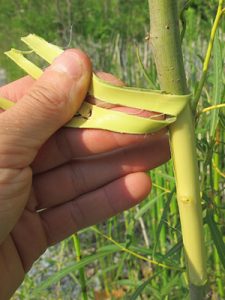 Derived from the bark of 2 to 3-year-old willow trees, which can be found worldwide, willow bark has been used for centuries to treat pain due to inflammation.
Derived from the bark of 2 to 3-year-old willow trees, which can be found worldwide, willow bark has been used for centuries to treat pain due to inflammation.
Willow bark works in the same way aspirin does by reducing inflammation and pain as it enters the bloodstream.
The Salicin within willow bark is metabolized to create salicylic acid, a precursor to aspirin. Willow bark’s pain-relieving abilities have been recorded as far back as the 4th-century.
Alternative health practitioners claim willow bark can be used to safely treat a variety of conditions, including headache, back pain, knee pain, osteoarthritis, and rheumatoid arthritis.
How To Use Willow Bark In A Survival Situation
Willow bark works well to relieve pain. Thus, this plant can be helpful in survival situations to relieve pain caused by inflammation when you cannot purchase aspirin.
You can use willow bark to create aspirin yourself, and it is a pretty straightforward process. While white willow tends to have the most concentrated amounts of aspirin within its bark, most people can usually identify a weeping willow and create a pain killer from this plant.
Create Aspirin From Willow Bark
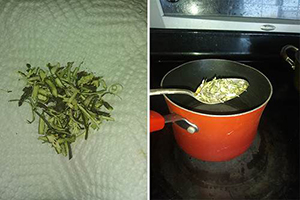 You can create aspirin by filling a jar 2/3 full of willow bark and cover it with neutral alcohol – such as vodka. Once full an inch from the top, place a cap tightly on the jar. Give it jar a good shake and store it in a cool dark place for a few months. Anytime you think of the jar, give it a shake.
You can create aspirin by filling a jar 2/3 full of willow bark and cover it with neutral alcohol – such as vodka. Once full an inch from the top, place a cap tightly on the jar. Give it jar a good shake and store it in a cool dark place for a few months. Anytime you think of the jar, give it a shake.
Once enough time has passed, strain out the willow bark and store the tincture in an amber dropper bottle. Keep this mixture in your survival kit for emergencies.
Related: How To Make Aspirin From Willow Bark
You can also create a tea from willow bark if you are in the wilderness by peeling the bark from the branch and soaking it in boiling water. You will want to drink up to 1 liter of willow bark tea to reap its medicinal benefits.
Willow Bark smells awful but tastes relatively pleasant. Some people even say it has a sweet undertone to it.
3. Turmeric
Turmeric is a spice that has become well-known for its healing properties. This spice, which gives curry its yellow color, helps to protect the body from radical molecules that can damage cells and tissue.
Uses
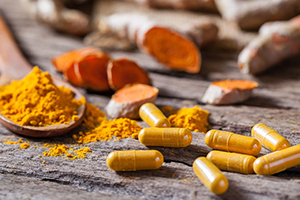 Turmeric has been used to treat various conditions, including indigestion, ulcers, stomach upset, psoriasis, and cancer. It is known to have anti-inflammatory properties, making it a good alternative for pain relief. The main active ingredient in Turmeric is curcumin, the compound that gives curry its yellow color.
Turmeric has been used to treat various conditions, including indigestion, ulcers, stomach upset, psoriasis, and cancer. It is known to have anti-inflammatory properties, making it a good alternative for pain relief. The main active ingredient in Turmeric is curcumin, the compound that gives curry its yellow color.
Curcumin works as an anti-inflammatory, making it an excellent alternative to relieve pain caused by inflammation.
How To Use Turmeric
Creating ointments from Turmeric is relatively easy.
To make Turmeric drops, you will need:
- 5 tbsp ground turmeric
- 1 Tbsp quercetin powder or an alternative (quercetin is an anti-inflammatory used to aid and prevent arthritis, bladder infection, diabetes, and cancers)
- 3-4 Tbsp of honey, Coconut oil, or ghee butter to use as a binding agent (a binding agent helps a mixture hold its shape by thickening it up and making it pliable)
- A pinch or two of ground ginger
- A bit of ground black pepper
Directions
1. Line a baking sheet with parchment paper and put it in the freezer.
2. In a small saucepan, heat your binding agent over low heat until it is pourable.
3. Mix the Turmeric, quercetin, pepper, and ginger in a small bowl and mix until you can form small balls.
4. Place balls onto a baking sheet and place it back into the freezer, freeze until firm.
5. Once frozen, remove the drops from the sheet, put them in a freezer storage bag or container.
6. Keep these turmeric balls in the freezer until needed.
Turmeric is good for you in many ways.
Related: How to Make All-Natural Homemade Turmeric Pain Pills
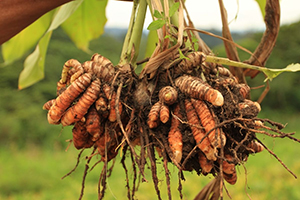
It is a natural anti-microbial, which means it will attack bacteria and infections.
It has been found to help prevent or stop the growth of certain types of cancers and reduce the risk of developing type 2 diabetes, among other things.
Along with the Turmeric Drops described above, you can also create pickled Turmeric using Turmeric root, known as one of the world’s most powerful healers.
How to Create Pickled Turmeric
Ingredients
- 1 lb – 1 ½ lbs raw, turmeric root, washed, peeled, and chopped into small, bite-sized pieces
- Enough apple cider vinegar to cover the turmeric root.
- The juice of one lemon
- 2-3 peppers, chopped into small pieces (The peppers help with the absorption of Turmeric.)
- Raw honey for sweetening
Directions
1. Fill a glass jar with pieces of fresh turmeric root that have been washed, peeled, and sliced. Top with chopped peppers.
2. Add the juice of one lemon.
3. Pour apple cider vinegar over the mixture, enough to cover the turmeric root.
4. Cap the jar.
5. Place the jar in a bright window for 1 to 4 weeks – Inverting the jar daily.
6. After 4 weeks, remove the cap and strain the liquid into a clean bowl.
7. Reserve half the liquid for salad dressing and store the remaining juice in the fridge for up to 1 year.
8. Place some of the remaining liquid in a small saucepan with honey.
9. Warm over low heat to incorporate the honey and vinegar mixture.
10. Pour the mixture back over the turmeric root, cap, and allow to steep another 1 to 4 weeks.
11. Store in a cool, dark place until needed.
The mixture will keep for up to a year and is delicious as a snack or salad topping.
4. Cloves
Cloves are a popular tool for cooking, but they may also help to alleviate pain as well. They can be purchased in capsule form, as a powder, or as an oil, and are easily obtained worldwide.
Related: What Happens If You Smoke Garlic Cloves
Uses and Risks
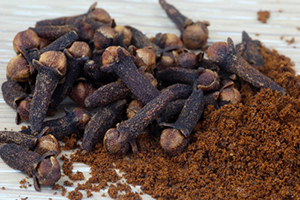 Cloves have been used to treat various ailments, including nausea and the common cold.
Cloves have been used to treat various ailments, including nausea and the common cold.
They may also help relieve pain. Hence cloves have been used to treat headaches, toothaches, and pain caused by inflammation such as arthritic pain.
People with bleeding disorders or those who currently take blood-thinning medications should be careful when using cloves products, as cloves have been found to increase the risk of abnormal bleeding.
How It Works
The active ingredient in clove oil is eugenol, a natural anesthetic with anti-inflammatory properties. Cloves may help reduce pain and alleviate inflammation.
Cloves are especially helpful in treating pain from toothaches and have been used for many years by people coping with tooth pain.
How To Use It
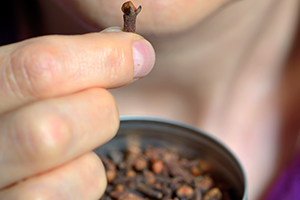 Dental health is vital, but in the event of an emergency, you may not be able to visit your dentist’s office as required or even obtain commercial toothpaste. Thankfully, nature has provided you with an excellent solution.
Dental health is vital, but in the event of an emergency, you may not be able to visit your dentist’s office as required or even obtain commercial toothpaste. Thankfully, nature has provided you with an excellent solution.
Research has shown that cloves hold significant potential when it comes to dental health.
They have been found to prevent plaque and reduce inflammation, making them a must-have addition to any prepper kit.
Related: 10 Home Remedies for Emergency Toothache Relief
You can apply cloves topically:
- 1 teaspoon of cloves, minced
- Using a damp cotton ball, dip it into the minced cloves.
- Softly rub the clove-covered cotton ball onto your gums where you have tooth pain.
- Allow the cloves to sit on your gums for at least a minute
- Rinse thoroughly with water to remove all of the cloves
While helpful, regular use of cloves in large amounts for extended periods is not recommended. However, in a survival situation, having cloves handy may prove to be very helpful for dental care.
5. Ginger
Ginger has been used for centuries in medicine and cooking. While it is not often used in the west, ginger is viewed as a natural healing agent worldwide and should be part of your survival garden.
Much like planting potatoes, you plant the buds that will grow off the rhizome of the ginger root or simply plant the entire budding root in the ground.
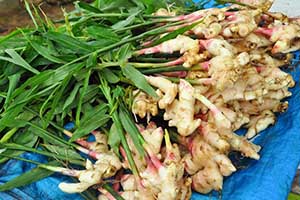
The ginger root plant grows best in rich, moist, shaded soil and can flourish in a shallow container.
Growing ginger root has many benefits and is often called a superfood. Ginger is thought to prevent stroke or heart attack, help with stomach upset, heartburn, or other GI issues, and ease motion sickness.
Ginger is also known to help alleviate pain and soreness associated with arthritis, muscle strain, or joint pain, making it an excellent tool in emergencies.
How To Use Ginger Root In A Survival Situation
Besides being good for you in general, ginger can be used to fight staph infection or strep, ease diarrhea, aid in alleviating menstrual cramps, attend to soreness from arthritis or joint pain, and may work to control diabetes. A recent study found that 2g of ginger root taken daily was linked to decreased resting blood sugar.
Related: How to Lower Your Blood Sugar Levels with Fenugreek
To reap the benefits of ginger root, it is best to eat ginger raw, candied, or by making a tea.
How to Make Ginger Root Tea
Ingredients
- Fresh Ginger Root
- 1 Lemon, sliced
- Honey for use as a sweetener
- Water
Directions
1. Chop fresh ginger into small pieces, cleaning and peeling the skin if needed. (Each cup of tea requires 1-2 slices of ginger.)
2. Add water, ginger, and lemon to a small saucepan and bring to a boil over medium-high heat, stirring regularly.
3. Reduce the heat to low and simmer for five minutes to seven minutes.
4. Strain into a teacup and add fresh lemon and honey.
5. Enjoy.
6. Ginger can help alleviate pain, relieve diarrhea, or aid menstrual cramps when you are in a bind and cannot get to a doctor or pharmacy.
Final Words
In an emergency, seeing your general practitioner or going to the hospital may not be viable options.
Unfortunately, pain does not care about the global climate and will persist despite the state of the outside world.
Knowing what is safe to use in treating pain and having it on hand can be highly beneficial.
Be sure that your emergency preparedness kit includes some of the items listed above so that you can treat your pain and focus on what is essential – survival.
You may also like:
 DIY Mini Greenhouse For Year-Round Vegetables
DIY Mini Greenhouse For Year-Round Vegetables
The Antibiotic Plant That Saved Venezuela After Pharmacies Ran Dry (Video)

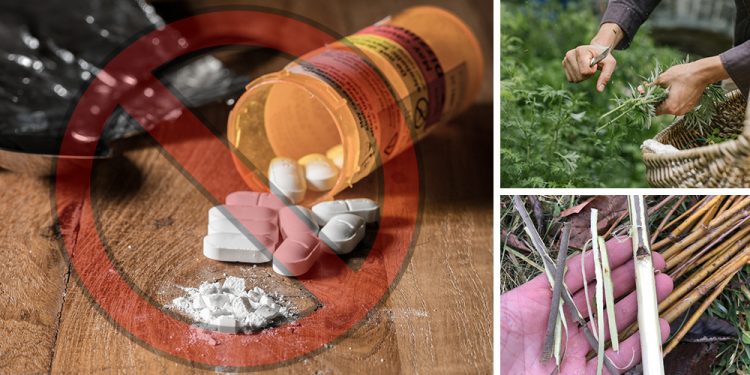













Very well done.!
With the exception of willow bark, to me this is mostly mild inflammation relievers, not real pain relievers that would relieve pain at the level of an opioid drug. Good to know as mostly BS and placebos, it’s better than nothing! Extra strength Tylenol is the way to go and is an excellent substitute for opioids especially for pain after major surgery. So, how do we make that?
CC: I refuse to take opioids no matter what. Even after surgeries, I’ve refused it because I saw too many die from it. I’ve read up on hypnosis and how-to for years; it’s been used since the 50s. Another thing to learn is Korean accupressure. If worse comes to worse, milk of poppy is easy to make, and they thrive in most of the world. niio
I agree most of these work best for inflammation. Kratom is a good option, however (if you are able to get it where you live) as it works in the same way that opiates do and helps to relieve all kinds of pain. Extra Strength Tylenol is a good choice for some people and some pain, but it does not always cut it. Many of these suggestions can also be used with Tylenol to help provide relief.
Now THIS is the way an article should be written. Well thought out, concise, and informative. It supplies you with enough information to actually use the ingredients for an intended purpose.
I am sure the questions will be: where can I get it? How long can it be stored? can I use a pink bottle instead of an amber bottle? I don’t like the taste of cloves. Is there something else I can use?
As preppers, knowledge is one of our most valuable tools. Without it, we are sheep waiting for someone else to take care of us. “Google is your friend” is a statement intended to let people know that a simple internet search will answer your most basic questions. “Surfing the internet” is following various links, (either related to your question, or topics that pique your interest) that will add to your knowledge. We cannot take the attitude that “ignorance is bliss” and hope to survive until our preps run out.
There is no such thing as a stupid question, but before you ask a basic question, at least have the courtesy to do a little research on your own. Articles like this one is what I hope to find when surfing the net. Ask A Prepper has members that add to the articles by expounding either direct knowledge of the subject, or passing along information gleaned by their own searches.
I look forward to the posts related to the articles, and really enjoy those posts that add to my knowledge base.
You didn’t mention wild lettuce.
Right?!
I absolutely love Wild Lettuce! It has changed my life immensely! I’m 58 and have been suffering with chronic pain for years. I have so many old injuries… neck, back, both shoulders, knees, feet. Pretty much living in misery every day. If anybody needed pain relief, it was me. ?
I’ve never been able to get help from doctors. I don’t know one that’s not afraid to prescribe pain meds.
Wild Lettuce has been a God send (literally). I just shared it with my 82 year old mom, an RN for over 50 years… She too, is amazed by Wild Lettuce!
A real life changer ??
I had honestly never heard of this until now. I will have to look into it further and learn about it. Thank you for sharing.
Grind the cloves into a powder, wrap a small amount of the powder in tissue paper to form a small pellet, wet the pellet, and insert it between tooth/gum and cheek.. It will last for hours and it’s more effective than benzocaine. This is a very popular toothache remedy that has been used for ages and is still quite common in old-world countries where there is limited access to modern medicine.
This is a great tip and one that my mother used on me when I was younger. It really does work. As an adult, I bought clove oil and used that when I have a toothache, it works as well but does not seem as effective as what you describe here. Thank you.
This was very informative I am really impressed by all the articles you posted I’m going to go out and buy these essential products and start me a greenhouse because I do have severe pain and without pain medicine I can’t get up and walk so thank you very much for posting this and I will continue to read your post and thank you so very much Gary
Gary. I am so sorry that you have to deal with constant pain. It is not something anyone should have to suffer through and I can relate. I hope that these ideas can aid you in finding some kind of relief.
Thank you, well done. Mind cloves because excessive use will mess with the heart. That can take years to develop and is usually common among clove smokers, cigarettes made only of cloves. niio
Aeesome article. Thanks so much!
Making asprin… Like any other medication over doses happen. I would like to know how much of the concoction would equal a standard tablet. While this is an article of good information it lacks actual recipes and suggested doses. This could lead to dangerous complications.
As with any other extraction, decoction, or distillate; there are too many variables to predict strenght of a given sample without lab assay. This being the case, in a true SHTF/EOTWAWKI situation, “first, cause no harm” , minuscule dose to start. Easier to fix not enough than too much.
Steve W – You just saved lives!
I can understand your concern here and I did try to seek out information on how much of each treatment should be used. However, because the amount varies from person to person – depending on the size/weight of the individual – it was impossible to say safely what would be an appropriate dosage on a general scale. I would suggest doing research if you are wanting to try any of these suggestions and start small. As another poster said, better to take too little than too much.
It appears that the turmeric ointment directions are missing something between steps 2 and 3. When do you mix the powders with the carrier?
You would heat the binding agent and then add it to the powders (or the powders to it) to form the mixture.
YOU FOR GOT ONE WILD LETTUCE EXTRACT
Wild lettuce has actually been studied a bit, rare for an alternative med, is a very effective pain reliever for 25%-30% of people in the studies. You just have to try it and see if it works for you, it has a big advantage over Kratom, Cucurmin, and cloves in that it grows everywhere. After a SHTF Kratom will be as hard to get as hydrocodone.
I have bad knees and a lot of chronic pain that I manage with extra strength Excedrin and one of the 4% Lidocaine creams. Extra strength Excedrin has outperformed opiates in pain relief studies, difference is it doesn’t get you high. Taken about ten opioid pills in my life, sure like the way it feels but I don’t see how you can be weak minded enough to let it run your life. Extra strength Excedrin is aspirin, tylenol, and caffeine, some people don’t have the stomach for it. Similarly, willow and cottonwood bark have the same dangers and side effects of aspirin, but like wild lettuce the plants are widespread.
I stock Ibuprofen and Extra Strength Excedrin in my preps, cheap and easy and they last several years when kept dry. Haha, my favorite niece sent me a couple of Cannibis lollipops because it’s supposed to be good for pain. I sucked about 1/3 of one last night, I don’t know about the pain but I sure did sleep hard! ’bout to experiment some more.
Judge: Don’t forget the poor, starving birds. When I lived in a certain place in the Midwest, I had a problem. I was counselling juvie delinquents, and there, cops got paid per arrest. The cops didn’t like losing all that ready cash. There were other things, as well, and they started to come down on me. ‘Someone’ told the kids that birds love pot seeds, but can’t digest them well. You know the rest.
A couple of deputies offered to take the cops who were causing problems and ‘talk’ to them about it. the count PA got involved and warned me the cops were looking for an excuse to arrest me. I asked about suing them but nope, can’t do that. But he said, I could sue the county. Then had a long, unpleasant talk with the co commissioners about the cops. Come spring, all those pretty plants came up all over and I got a dirty look from some folks, but by now half the town was booing the dirty cops. niio
Judge Holden:
Time to break out the old LPs from the sixties and seventies, put on some patchouli incense and finish that candy! Lol!
Joking aside, cannabis as a medicinal plant is something we should be considering. It’s been used in Asia for millennium for pain management and insomnia, and it’s legal in a lot of places now. It’s also fairly easy to grow and the seeds can be used as food.
Miss Kitty, you are right, cannabis can be very effective for pain relief and it is usually available through a doctor even if you are not lucky enough to live somewhere that has decriminalized it. In fact, there are doctors you can see online that can prescribe it if you do not have a doc that will. I personally do not enjoy the effects of cannabis and it never really improved my pain, but for some, it is the answer they have been looking for and is definitely worth a try when you are suffering. Thanks for sharing this.
I HAVE TAKEN WILD LETTUCE I RECOMMEND IT TO ANY ONE WITH CHRONIC PAIN LIKE MINE 10 DROPS UNDER THE TONGUE MORNING AND NIGHT YOU CAN GO 35 DROPS A DAY. I TRIED EXCEDRIN DID NOTHING WHY MY PAIN LEVEL IS SO HIGH. I SUGGEST EVERYONE HAS THIS IN THERE ARSENAL TO TREAT PAIN AND TIGER BALM
Thank you for sharing. I did not include it here simply because I have no knowledge of it but I will be looking into it now. I agree, Tiger Balm is amazing for relief, especially when it comes to muscle pain. I always keep some on hand and use it often.
Is there anything that can be used for insomnia?
Turn off the news, lol.
My mother told me her dad would suck on a couple of clover Sunday morning before church as a breath freshener.
A bath with Epsom salts
some exercises before bed help. niio
Valerian root works for my insomnia. You have to experiment with how much though. If I take too much, I have nightmares.
Donna:
Valerian, cannabis, chamomile, warm milk (yes, it does work) and melatonin are all things you can try, but the real way to treat it is to examine the root cause.
Are you in physical pain? Are you upset about something? Is your bedroom noisy/hot/too bright? Are you just coming off working a night shift? Do you do a lot of computer work or work on a smartphone before bed? Did you have Covid? All of these can disrupt your sleep. Covid is probably the least well known, but many people who have had it experience insomnia afterwards, according to what I’ve read. I don’t know why.
Once you identify the cause and correct what you can, then you should have better luck sleeping, with or without the herbals and supplements.
Donna – Try tart cherry juice. Make sure it says tart cherry juice as a first ingredient on the label. It will naturally help replenish your level of melatonin which decreases as we age causing many unnecessary sleepless nights.
Insomnia is awful. I have suffered from it on and off for many years. There are a lot of natural things that you can use to help you sleep. Honestly, a quick google search will provide you with an ample amount of info, but I suggest looking into Valerian Root, Essential Oils, and even Magnesium. All of these things promote a calming effect and may help ease you into a peaceful slumber. It would depend on why you can’t sleep though. If the lack of sleep comes from pain, you want to address this issue first (there are types of Kratom that make you sleepy) but if the insomnia is caused by something else you may need a different approach. It is quite personal and highly dependent. I will look into writing an article on this in the future though. Good luck.
FOR ANY ONE NOT SLEEPING TAKE A TWIG OF ROSEMARY CRUSH IT UNDER A WARM BATH TAP THE THE SMELL WILL LULL YOU INTO A DEEP SLEEP
When I had to drive into the city to work I often kept a few branches of rosemary under the seat, such a calming aroma. Lots of wild lettuce in my wildflower patch, it has gone to seed, some of the seed heads are 7-8 feet high. I need to get motivated next spring and make an extract from it.
https://www.skilledsurvival.com/wild-lettuce/
I dried a boxful to work on later. Rather than pull plants, I cut them off above ground to allow them to regrow. niio
It would be great if you included maybe what Countries plants and trees can be found in..I’m a prepper in Australia..Great Articles always find something interesting to read..Your my go to page..As the World has ended as we know it..
Dang spell check! Cloves! My grandpa sucked on Cloves as a breath freshner.
City Chick: This article is 100% good and important information! I must ask are you related to Illini Warrior or are you
just OTR?
Go back to MSB where you can all tell each other how smart
and wonderful you all are.
Dear Kay relax. City Girl’s comments are reasonable. I’ve read the article and have used all the mentioned herbals. They do have some mild effects compared to Aleve and such. BTW Medically speaking (Over 40 years worth of experience before retiring) Placebos and BS meds DO have a useful effect on my problems including harsh pain issues. In Israel Dr’s are encouraged to write for Placebos for many issues.
The folks in the comments that brought up wild Lettice did ask a good question why it wasn’t mentioned. I know it works quite well and indeed I have a tractor tire patch I planted for easy harvest.
ODD you didn’t attack THEM for questioning the article’s lack of Wild Lettice?
Comparing anybody to IIini Warrior is quite an insult. Are you related to him/her/it?
BTW your posting style is exactly like “Sam” that came over to my favorite site to Attack City Girl for posting here on Ask A Prepper. That’s why I was curious enough to seek out the “Offending” posting here. Maybe YOUR IIini Warrior posting under a new name perhaps?
Michael:
Ilini Warrior was seldom as bitchy. Maybe “Kay” is “OTR” herself. Get them both some chocolate and pamprin and hope they get over it.
I feel bad for not adding ‘Wild Lettuce’ it was an oversight on my part and seeing the interest, I will be making a note to create an article on it in the future. I did not intentionally leave it out, I just did not have sufficient information at the time of this article. However, I am now going to learn about it and add that information to this site in the future as it sounds like a good option.
When I post it’s never my intention to cause a stir or offend anybody. If I have somehow done that, I sincerely apologize. I post with the hope that I am making a contribution to the ongoing discussion by sharing information and expressing my honest opinion. The lively exchange of ideas is what makes this site so invaluable and that I believe helps each and everyone of us regardless of the topic at hand.
City Chick:
You did sound a little cranky… you’re not usually that curt so I figured you might just be stressed. Chocolate fixes cranky… and a lot of other things, lol. But as W.C. Fields said “Candy is dandy, but likker is quicker”.
Have a glass of wine or whatever and try to relax . Life is too short to waste time on the small stuff.
Have a good week.
Miss Kitty – Yes, indeed! What got my dander up was actually the title of the article, “5 Natural Pain Killers to Use Instead of Opioids”. My comment was in part to the lack of any comparison of the potential strength of these herbal remedies to that of opioids, when and how to administer them. Every drug, herbal or otherwise, is a poison if it is not administered properly and for the right condition. In my opinion, a more fitting title would have been “5 Natural Pain Killers”.
CC: It’s rare that you’re anything but respectful and are respected here! I think someone had a fit of jealousy and that we do not want here. Peace. Remember the old Mexican saying, their words are like my belly. A sharp pain, loud noise and a stink, then nothing. walk in beauty
Red:
Weren’t we talking about jimsonweed on one of the other topics a few days ago? As I recall, it can be used topically as well as internally, and is perhaps better that way because it can cause hallucinations.
In reference to? Jimsonweed is datura/witchweed, and while native, it’s illegal to have here. It has no medical value and any Indian caught with it by others gets Granny’s ax in the heart. But, if in a real bind and going to die anyway, a bite of root and a snort of coke turns a person into a tireless killing machine. Datura will slow blood loss and pain to some extent. I think the record number of bullets Big Rez cops used to kill one was 16 bullets and the jerk still didn’t die till his heart exploded. Sacred (to black magic witches) datura is in bloom all over here now.
niio
Red:
I was thinking in terms of its use as a painkiller/sedative, rather than the thaumaturgical.
Miz Kitty: Yeah, it might be useful such as cases of bleeding, but it’s so dangerous even long-time herbalists will not recommend it. Researchers are still trying to sort it out, to remove the LSD from it. niio
City Chick:
I agree…most of these don’t pack anywhere near the same punch as an oxycodone or Vicodin tablet and if you have a broken leg or have had your appendix out your going to need something stronger than curry to get through the first couple of days, anyway. Chronic pain is another thing altogether.
I wonder why wild lettuce wasn’t mentioned in this article… maybe because of the in depth article that ran a little while ago?
Not adding Wild Lettuce was an oversight on my part, it sounds like it would fit here perfectly. However, I will look into adding it later to another article as it seems there is interest. I agree with you that many of these are not comparable to oxycodone but that is mostly because nothing is comparable. It is sad because opiates work for some people and work on some pain very well, yet they are impossible to get from any doctor. The point of this article was to list easily accessible options for mild to moderate pain. Outside of Kratom, which I stand by as being an effective opiate alternative, some of these will not work on some people, others will. It is trial and error when it comes to pain and oftentimes you are on your own to figure it out.
Passion Fruit is helpful with insomnia.